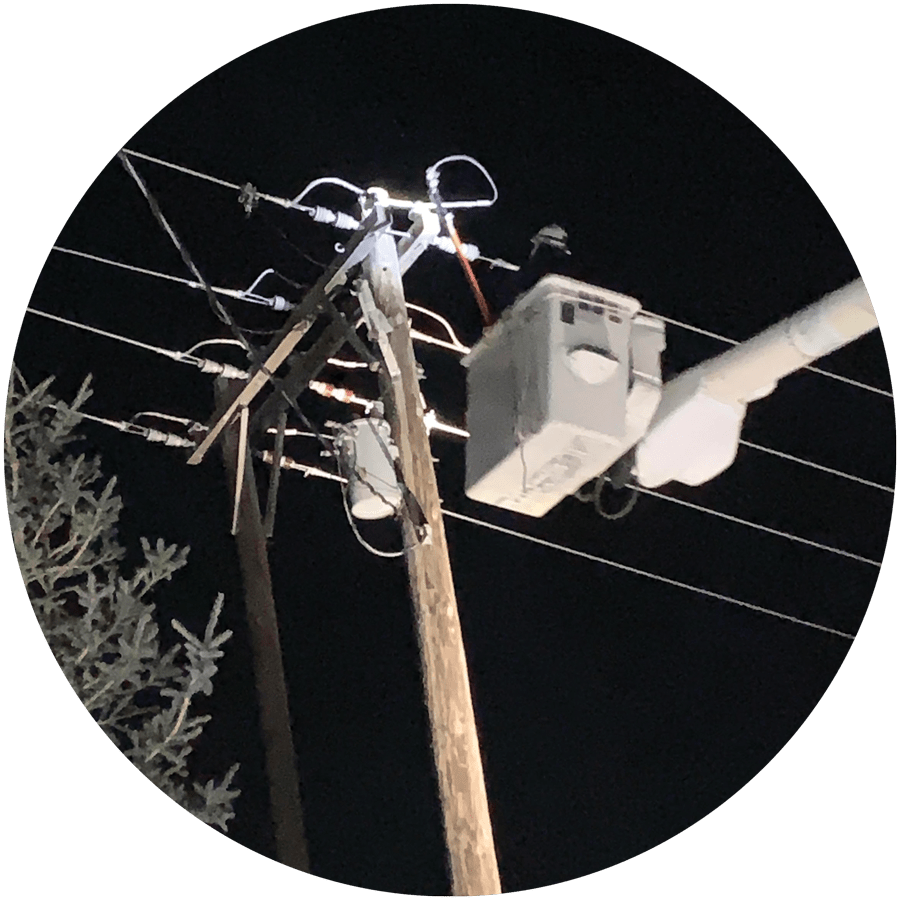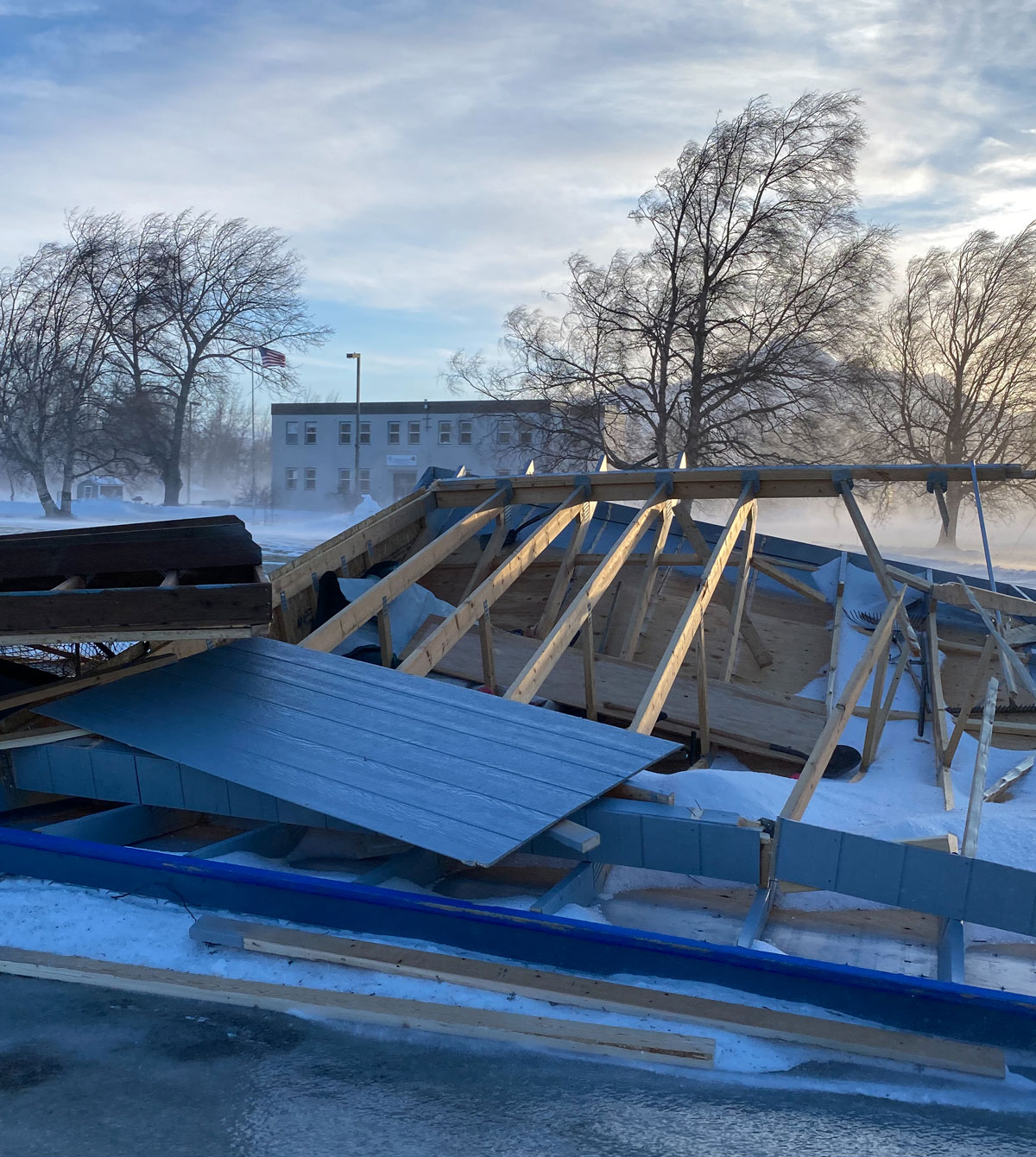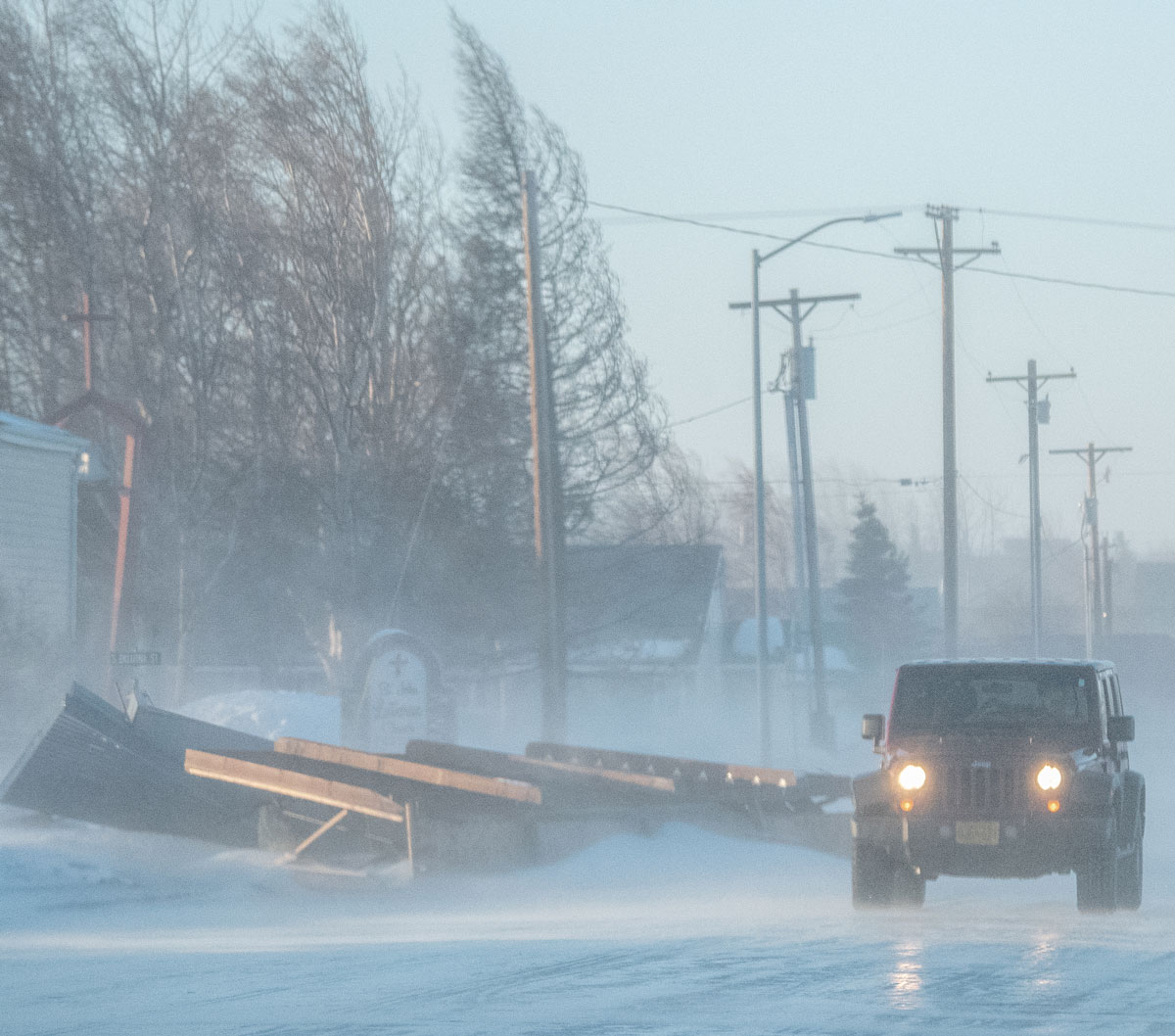Photo courtesy of MEA

Photo courtesy of MEA
his year began as an intense episode of Life Below Zero as Southcentral Alaskans experienced a mix of snow, rain, and wind storms that flipped over prop planes, destroyed road signs, and caused extensive property damage.
Residents of the Matanuska-Susitna Borough hunkered down as winds gusted up to 90 mph over the new year, leaving many without power for an extended period of time. Matanuska Electric Association, or MEA, launched crews and collaborated with other utilities and private companies to quickly restore power to the 22,000 members that lost it during the storm. Some residents and businesses are still waiting on local businesses to make storm-related repairs.
The National Weather Service issued a weather advisory on Friday, December 31, warning of steady winds of 35 to 40 mph with gusts of up to 75 mph over the weekend. MEA immediately put crews on standby. By 7 a.m. Saturday morning, hundreds of members had lost power as winds knocked trees onto powerlines. Gusts up to 90 mph, with sustained winds of 45 to 60 mph continued through Sunday when MEA reached its peak outage point of 22,000 members. The National Weather Service extended the wind advisory until Wednesday. By then, crews from Golden Valley Electric Association, or GVEA, in Fairbanks; Chugach Electric in Anchorage; and Northern Powerline Constructors, Inc., or NPC, joined MEA linemen to reestablish power in the area.
Six GVEA linemen, twelve from Chugach Electric, and contract crews from Electric Power Constructors Inc., Northern Powerline Constructors, Alaska Line Builders, Fullford Electric Inc. and Sturgeon Electric helped more than double MEA’s linemen response capacity. This allowed a staggered rotation of twelve to sixteen line crews to work sixteen-hour shifts with an eight-hour rest so that repairs continued without interruption.
Most outages are handled by a two-lineman crew; however, problematic areas in need of replacement parts and specialized equipment required a four-man crew. By Monday evening, crews were cutting the outage numbers down by half roughly every twelve hours after the outages peaked at 22,000 Sunday afternoon. By Friday afternoon power was restored to all members except for seven locations with damage to their electric infrastructure.
“There were a handful of members we couldn’t immediately connect due to damage on their side of the meter,” says Jennifer Castro, public relations manager for MEA. “They had to get an electrician to make those repairs on their side so we could turn their power back on. In some cases, we were able to set a temporary connection until they could schedule an electrician; for others there was just too much damage.”
In a typical Mat-Su windstorm, Castro says wind speeds average 15 to 30 mph with gusts around 45 mph for a day or two. At those speeds, MEA might see a few hundred outages that are resolved in four to eight hours by MEA’s line crews. With this windstorm, restoring power took more time because of the extensive damage and extra precautions needed to keep the linemen safe.
“Working in a bucket truck under those conditions is not ideal,” says Castro. “We all did it safely. That’s the true success story.”

Photos courtesy of MEA
Photos courtesy of MEA

Timing played a big part in GVEA, Chugach Electric, and contract crews being able to assist. Though Fairbanks had just experienced extensive snow and rain the week before, most Interior power outages had been addressed by January 1. Josh Davis, director of operations for GVEA, says he was in contact with DJ Davis, the line superintendent for MEA, soon after the National Weather Service issued the first weather advisory. MEA had sent crews to Fairbanks to allow rest time for GVEA linemen who had worked tirelessly to restore power throughout the Interior. However, once the windstorm hit the Mat-Su Valley, MEA crews returned, along with two GVEA crews.
Davis says the destruction in the Mat-Su was more extensive than what crews saw in Fairbanks.
“In Fairbanks, we had tops of trees broken. In Mat-Su, the entire tree broke,” says Davis, “big trees laying across lines. And the destruction was not limited to power lines. Everything got destroyed. People’s sheds and roofs were blown away, things were knocked over or simply blown apart.”
NPC President James Zehnder, who also sent crews to Fairbanks prior to assisting MEA in Mat-Su, describes the Mat-Su as “a little apocalyptic” during the wind storm.
“Trees and anything not tied down was getting uprooted and repositioned,” says Zehnder, “sometimes many miles from where it originally sat. Fairbanks was quite different. The only thing that looked out of place was the ice. It was everywhere.”
Julie Hasquet, senior manager of corporate communications for Chugach Electric, says Anchorage remained relatively calm during the nearby storm, which allowed them to provide assistance.
“It goes without saying that Alaskans help each other in an emergency,” says Hasquet. “Since the storm was not impacting the Chugach service territory in any significant way, we had personnel available to help MEA when they needed it. That’s how utilities are in Alaska. We help each other when we can. We know MEA would do the same for us.”

Photo by Emily Hinman

Photo by Emily Hinman
Communication with the public is a top priority during a crisis. Winter power outages can quickly become dangerous for homes without a backup generator or a second source of heat. Castro says she and one other person on the PR team rotated shifts so they could regularly update members about outages. MEA posted to Facebook every two to three hours in addition to placing a visible status bar and an outage map on their website. However, the public was also actively communicating with MEA in a way they don’t typically. When MEA’s voicemail reached capacity, members used Facebook Messenger to check on their outage status, report trees on the lines, and let MEA know about safety hazards in their area such as fallen trees blocking road access.
“It’s the first time we’ve seen a large group of our members use Facebook this way,” says Castro.
To best serve members, the PR team stayed in the dispatch center for the following week with Facebook Messenger open, passing information about reported outages to dispatch. They also responded to direct messages asking for an outage update in their area. Castro estimates that they were receiving on average a message a minute during Monday and Tuesday of that week.
“It’s important that we stay as responsive as possible in a crisis situation,” says Castro. “Our members are literally in the dark and communicating prevents them from feeling completely forgotten and alone.”
Immediately after the storm ended, private companies began receiving calls for repairs. Roofing companies, in particular, received a large number of calls, as property owners saw a wide range of damage to homes and businesses.
Jason Dial, vice president of Rain Proof Roofing, says the increased calls required their Mat-Su office to pull staff from their Anchorage location to assist with estimates and repairs. Since the damage happened during a catastrophic event, Dial says his staff is spending additional time writing proposals for insurance companies. Since the integrity of a roof is vital to the health of a home, Dial says some homeowners will pay out-of-pocket for repairs while they wait for insurance approval.
“Insurance proposals definitely add time to the process,” says Dial. “And I hate nothing more than to tell someone they have plywood showing and they have 3 weeks to a month before repairs can happen.”
He says exposed roofs can potentially lead to ruined finishes, damaged insulation, heat loss, or worse.
MEA will apply for state emergency funds and research Federal Emergency Management Agency assistance that might cover storm-related costs. Castro says it’s a long process and funds, if approved, won’t arrive for several months. For now, they are looking for ways in-house to pay for everything. Overall, she says this windstorm was a big reminder that even a four-hour storm can be catastrophic, if it’s big enough. She strongly recommends members invest in an emergency food cache and generator or a second source of heat since it seems wind events are becoming more common in Mat-Su.